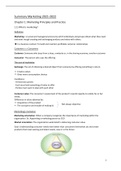Summary Marketing 2021-2022
Chapter 1: Marketing Principles and Practice
1.1) What is marketing?
Definition
Marketing = A social and managerial process by which individuals and groups obtain what they need
and want trough creating and exchanging products and value with others.
➔ In a business context: To build and maintain profitable customer relationships
Customers <-> Consumers
Customer: Someone who buys from a shop, a website or, in the sharing economy, another costumer
Consumer: The person who uses the offering
The core of marketing
Exchange: The act of obtaining a desired object from someone by offering something in return.
Creates values
Gives more consumption choices
Conditions:
- At least two parties
- Each must hold something of value to offer
- Parties must want to deal with each other
Costumer value: The consumer’s assessment of the product’s overall capacity to satisfy his or her
needs.
Difference in value obtained by:
Acquisition of the product
Not always objective
The cost (price and trouble of making it)
Market(ing) orientation
k
Marketing orientation: When a company recognizes the importance of marketing within the
organization. Ex. Appointing a marketing person as CEO
j
Market orientation: The organization-wide belief in delivering costumer value
Goal: Understanding consumer needs even better than consumers themselves do and create
products that meet existing and latent needs, now or in the future
1
,Developing a market orientation:
- Customer orientation = Measuring customer satisfaction on a continuous basis and training front-
line service staff.
- Competitor orientation = Developing an understanding of your competitors’ short)term weaknesses
and strengths and your own long-term capabilities and strategies.
- Interfunctional coordination = All functions of an organization need to work together for long-term
profit growth.
It is sometimes better to please a lower part of the population, but only if it is profitable
Marketing intellectual roots
Marketing as a discipline has developed as a result of the influence of its practitioners, but also
developments in these domains:
- Industrial economics influences:
o Supply and demand (price, quantity)
o Theories of income distribution, scale of operation, monopoly, competition, …
o Psychological influences, Consumer behavior, motivation research, information processing
o Persuasion, consumer personality, customer satisfaction, …
- Sociological influences
o How groups of people behave: Demographics, class, motivation, customs, culture
o How communication passes through opinion leaders, …
- Anthropological influences
o Qualitative approaches in researching consumer behaviour
o Ethnography, netnography and observation
- Computer science influences
o Digitization, recommendation systems, apps, …
The development of marketing
Production period – Sales period – Marketing period – Societal marketing period –
characterized by a focus characterized by a focus characterized by a more characterized by a stronger
on physical production on personal selling advanced focus on the focus on social and ethical
supported by market customer’s needs. This concerns in marketing. This
and supply, where
phase is taking place during
demand exceeded research and advertising. phase took place after the ‘information revolution’
supply. This phase took This phase took place the Second World War. of the late twentieth
place after the industrial after the First World War. century.
revolution.
1980s to
1890s-1920s 1920s-1950s 1950s-1980s
present
2
,Difference between Sales and Marketing
Marketing is about understanding and communicating with the clients for the design, delivery,..
Sales is organized for enhancing the distribution and solicitation of the companies’ offerings once the
offerings already have been designed
Marketing Sales
Tends toward long-term satisfaction of Tends towards short-term satisfaction of
costumer needs costumer needs; part of the value delivery
process as opposed to designing and
development of costumer value process
Tends to greater input into costumer design of Tends to lesser input into customer design of
offering (co-creation) offering
Tends to high focus on stimulation of demand Tends to low focus on stimulation of demand;
more focused on meeting existing demand
1.2) Marketing: Application and relevance
Application
Physical products, services, retail, experiences, events, film/musical/theater, places, ideas, charities
and non-profits and people.
Anywhere “buyers” have a choice
What do marketers do? They are..
Aware of everything, an active learner, able to function as a marketeer, accomplished and
authoritative
1.3) The marketing process
A functional map for marketing
- Influencing (other employees, customers,..)
- collaborative (for example with channel partners)
- Responsible (for one’s acting and acting ethically)
- Financially literate
- Inspiring
- Innovative
- Challenging
- Entrepreneurial
- Commercially aware
- Creative
3
, Marketing as exchange
Costumers also give input in marketing
strategies: They specify how to satisfy their
needs => marketeers can’t reed their minds.
This is one of the values costumers (and
other stakeholders) gives other than the
purchases.
Simple marketing exchange process (examples)
Offering, credit facilities, return facilities, distribution arrangements, other services
1) Manufacturers Retailer
Money, wholesale price for goods
Offering, return facilities, (online) distribution arrangements, costumer services
2) Retailer Customer
Money, retail price for goods
Offering, credit facilities, return facilities, distribution arrangements, other services
3) Manufacturer Customer
Money, price for goods
Keeping public order including protection from crime and terrorism
4) Police Customer
Public funds, suspicious activity reporting and cooperation
Provision of services for those in need, typically third parties
5) Charity Donors
Donations and volunteering
Higher education, career and counting professional development services
6) University Student
Public funds, donations, philanthropy, course fees and research grants
Marketing in context
- The Consumer Goods Perspective
Consumer goods = Convenience goods (purchased frequently, minimum effort), shopping goods
(purchased selectively), or specialty goods (purchased highly selectively).
This perspective assumes that there are comparatively few suppliers within a particular industry
and assumes that there are rivals for Aggregated demand (= Demand totalled at population rather
than individual level)
Fast-moving consumer goods markets: Price is clearly defined, consumption takes place later
(demand stimulated by the promotion mix: advertising, personal selling, digital and PR)
Focus of marketing: How to ease the rapid exchange of goods, the effectiveness of marketing in
matching supplier offering to customer demand and efficiency in managing the product-distribution
!!! Important: Principles and practice of multichannel marketing and retailing. !!!!
4




